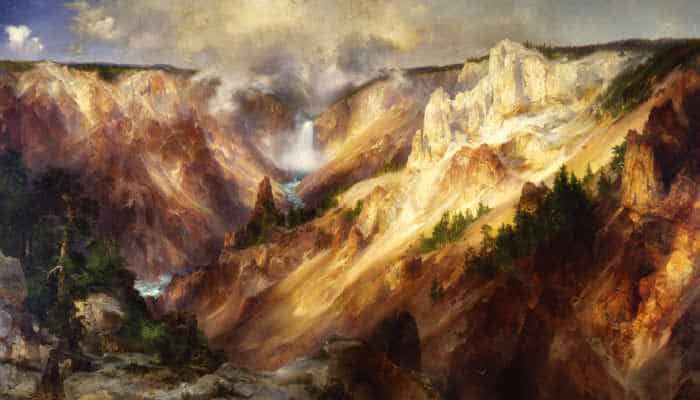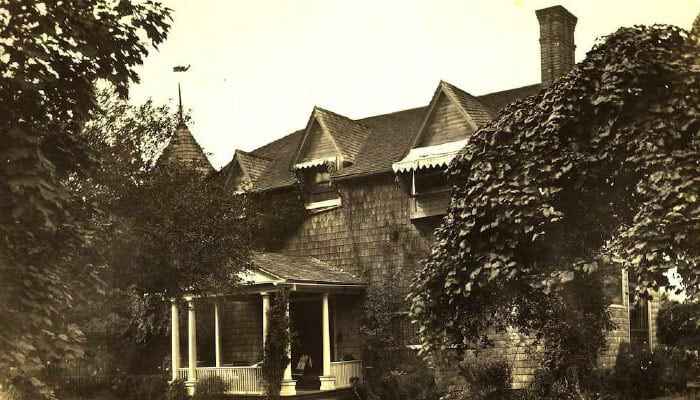When it comes to the rehabilitation of important houses in the Hamptons, celebrities come out of the woodwork to help. So was the case this past summer when such local luminaries as Cindy Sherman, Larry Gagosian, Kim Cattrall and Nicole Miller manned the committee for a benefit to fund East Hampton’s Thomas Moran House. The event allowed partygoers to get a sneak peek at the structure, which was nearing the end of a painstaking restoration. (Restoration officially ended in December and the house will open to the public in early June.)
Artist Thomas Moran (1837–1926), himself, was also a superstar in his day. A painter of the Hudson River School, he was best known for his landscapes of the American West, especially his canvases of Grand Canyon and Yellowstone – a then unknown wilderness that his images introduced to his countrymen. The works of the “exquisite colorist,” have hung in the U.S. Capitol building and the White House.

After building their home on Main Street in 1884, Moran and his wife, Mary Nimmo Moran – famous in her own right as an etcher and landscape painter – lived in it several months a year while not on expeditions to far flung locales – places where “god and nature were obvious,” according to East Hampton Historical Society Curator Richard Barons. The couple lived there until their deaths and are buried across the street in the South Side Cemetery nestled next to the town pond.
“The Moran house was the first purpose-built artist’s studio in the Hamptons and they had a ball including fancy-dress parties, a sea monster weather vane, and an ornate Venetian gondola launched on Hook Pond,” says Frank Newbold, an agent at Sotheby’s International Realty. “We should all be proud to have the studio restored as a center for East Hampton’s artistic and cultural community.”
The main room in the house – a grand affair with high ceilings and huge windows – was not used as a living room, but rather as the artists’ studio. As such, it contained little furniture. What we can see in photographs are Moorish lamps, a Chinese fern stand and an ornately carved Indian marriage chest that they brought back from their travels.

Many of the house’s built-ins were scavenged from other properties including the front door, an elaborate bay window and the studio’s large-scale windows, which seem oddly out of place till you discover they were from a candy store on Lower Broadway.
When the Morans arrived in town “the community was very excited,” says Barons. And the Morans were quite involved locally. An early member of the Maidstone Club, Thomas raised funds for the institution.
A subsequent owner Condie Lamb, who established an eponymous real estate agency in 1963 that was purchased in 2016 by Compass, worked to get the home declared a National Historic Landmark in 1965. When she died in 2004 she bequeathed the structure to Guild Hall, which in turn deeded the property, which had fallen into severe disrepair, to the Thomas Moran Trust in 2008.
“It is hard to imagine the poor state of the house when I first approached it about five years ago,” says Barons. “The floors were rotten; the ceilings exposed wet wooden lath. The weathered exterior shingles clapped against the walls when there was a wind. The roof leaked and when it rained, water gushed out of the studio’s fireplace like spilling from an overturned bucket. A floundering sagging Victorian folly that seemed unrepairable.”
An education committee will determine the exhibits to take place in the edifice, which has been returned to its former glory.

















![Looking to add a little drama to your garden this summer? 🌸 Dahlias bring bold color, sculptural blooms, and long-lasting beauty from midsummer through fall. With a little care and the right conditions, these radiant flowers will keep your garden blooming straight into the crisp days of autumn. [link in bio]](https://hamptonsrealestateshowcase.com/wp-content/uploads/sb-instagram-feed-images/503714701_18517502149030135_4173113047766209727_nfull.webp)

![A design-forward retreat in the heart of Amagansett 🌿 Tucked behind a tree-lined drive, this thoughtfully maintained home offers sun-filled living spaces, inviting outdoor patios, and a peaceful, pastoral setting complete with a gunite pool, spa, and flower meadows.
360 Town Lane, Amagansett
Represented by @nataschatillmannshamptons of @sothebysrealty [link in bio]](https://hamptonsrealestateshowcase.com/wp-content/uploads/sb-instagram-feed-images/509787626_18517111003030135_4811500639484722701_nfull.webp)

